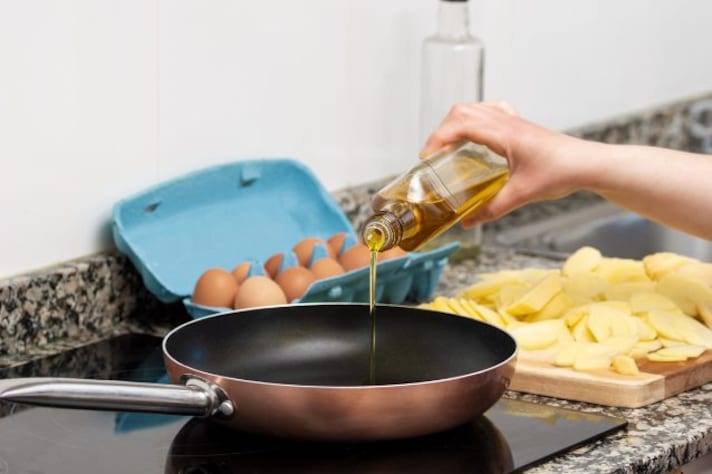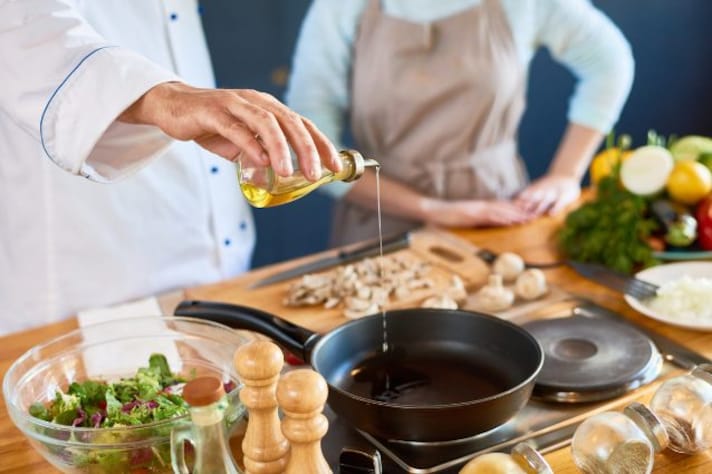
There are plenty of sayings and urban legends that have been repeated so often, people just assume they’re true. Some of the classics include “you need to wait 30 minutes after eating before swimming” or “you’ll catch a cold if you go outside with wet hair.” One myth that has lingered in the culinary world is that frying food in olive oil is dangerous to your health. But is this warning based on science, or just something people have accepted without fact-checking? Let’s dive into the truth behind frying with olive oil, and what the USDA has to say about it. Spoiler: it might just surprise you!
Why People Think Frying with Olive Oil is Dangerous
The fear surrounding frying with olive oil largely comes down to one factor: its smoking point. The smoking point of an oil is the temperature at which it starts to smoke and break down, releasing free radicals and other compounds that are thought to be harmful. Olive oil, particularly extra virgin olive oil, has a relatively low smoking point compared to oils like canola or sunflower, and this has led to the widespread belief that using it for frying is unsafe. Some even claim that it becomes carcinogenic when heated too much. The smoke produced can certainly set off alarms—both literal and figurative—but does it mean olive oil is hazardous for frying? Not quite.

What the USDA Says: Yes, You Can Fry with Olive Oil
According to the USDA and various food safety experts, olive oil can indeed be used for frying, as long as it’s done properly. The smoking point of olive oil is lower than some other oils, sitting between 350-410°F (177-210°C), but this is still well within the range for many frying techniques. The USDA confirms that olive oil, including extra virgin olive oil, is safe for frying, provided you monitor the temperature and don’t overheat it. The myth that olive oil turns into a health hazard when heated simply isn’t backed by science. In fact, olive oil is packed with heart-healthy fats and antioxidants, which are often retained even after cooking. So, rest easy—your olive oil isn’t going to poison your next batch of crispy vegetables!
How to Fry with Olive Oil for the Best Results
If you’re going to fry with olive oil, there are a few simple tips to follow for the best results. First, stick to shallow frying or sautéing rather than deep frying. Olive oil’s slightly lower smoking point means it performs better for gentler frying methods that don’t require the high heat of deep frying. Make sure to keep the oil at a moderate temperature—around 350°F (177°C)—and avoid letting it overheat. Use a good kitchen thermometer to stay within the ideal frying range. You’ll also want to choose the right type of olive oil. Extra virgin olive oil is great for its flavor and nutrients, but if you want something more neutral for frying, refined olive oil (sometimes labeled "light" olive oil) has a higher smoking point and a milder taste.

When Not to Fry with Olive Oil
While frying with olive oil is generally safe, there are times when it’s better to opt for another oil. If you’re deep frying at higher temperatures—above 410°F (210°C)—it’s best to choose an oil with a higher smoking point, like vegetable or peanut oil, to prevent smoking and the breakdown of the oil. Additionally, because olive oil has a distinct flavor, it’s not always the best choice if you’re frying something delicate that you don’t want to overpower, like a light tempura or certain desserts. In these cases, a more neutral-tasting oil works better.
;Resize,width=767;)
